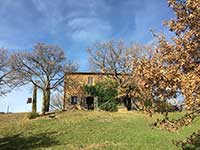| |
|
The main fountains in Siena are Fonte Gaia, Fontebranda, Fonte d'Ovile, Fonte Nuova d'Ovile, Fonte di Follonica, Fonte del Casato (also called Fonte Serena) and Fonte di Pescaia.
Minor fountains are Fonte delle Monache, Fonte di San Maurizio, Fonte di Pantaneto, Fonte dei Pispini, Fonte di San Carlo, Fonte dell'Orto Botanico; Fonti nella valle di Porta Giustizia, Fonte del Laterino, Fonte delle Sperandie; Fonte Caccialupi, Fontebecci, Fonte delle Cannelle, Fonte della Prodaia and Fonte Serena.
|
|
|
|
| |
|
Fonte Gaia
|
|
|
The Fonte Gaia is a monumental fountain located in the Piazza del Campo in the center of Siena.
The first fountain in the Piazza del Campo was completed in 1342, after hydraulic construction had led water to the site. Underground pipes brought water to the site from 25 kilometers away.[1] Legend holds that the fountain was met with much joy, thus it was given the name Gaia or joyous. Others suggest the term Gaia refers to the Latin term for "bride", and that the fountain was dedicated to the bride of God and patron of Siena, the Virgin Mary.[2] The fountains, plates, and statues conflate Roman matrons' cardinal virtues, with a central depiction of Mary, curiously framed by stories of Genesis.
In 1419, the fountain had the present decorative frame constructed by Jacopo della Quercia. In 1858, the original marble panels were replaced by copies sculpted by Tito Sarrocchi, under the supervision of architect Giuseppe Partini. The side reliefs depict episodes from Genesis: The Creation of Adam and The Flight from the Garden of Eden. The wolves spouting water, representing the mother-wolf of Remus and Romulus, form part of the reconstructed fountain. Two nude female figures once adorned the front two columns, traditionally believed to represent Rea Silvia and Acca Larentia, in celebration of Siena’s supposed links to ancient Rome. These were not added in the reconstruction but can be viewed along with the original panels at a museum at Santa Maria della Scala, the old hospital overlooking the Piazza del Duomo. The long section of the fountain is adorned at the centre with a Madonna and Child, surrounded by allegories of the Virtues.[3]
|
|

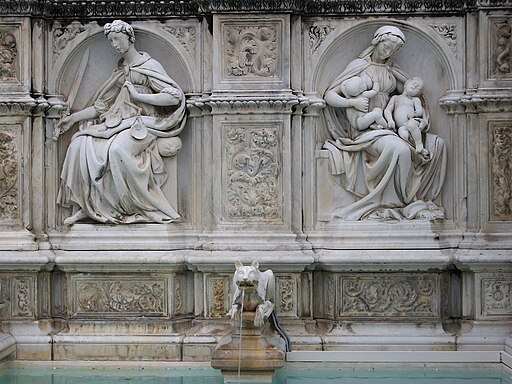
|
Fontebranda
|
|
|
Fontebranda is one of the medieval fountains of Siena, located in Terzo di Camollia, in the Contrada of Oca, near the Porta of Fontebranda.
History
The fountain was built in the 13th century by the Guild of the Wool-makers (Lana). The first mention of a fountain was in 1081, and documents speak of enlargement by Bellamino in 1193, and finally rebuilt in its present form in 1246. The fountain is cited by Dante Alighieri in the Divine Comedy (Inferno - Canto trentesimo | Inferno XXX, vv. 76-78).
|
|
 |
| |
|
Fontebranda fountain and Basilica di San Domenico
|
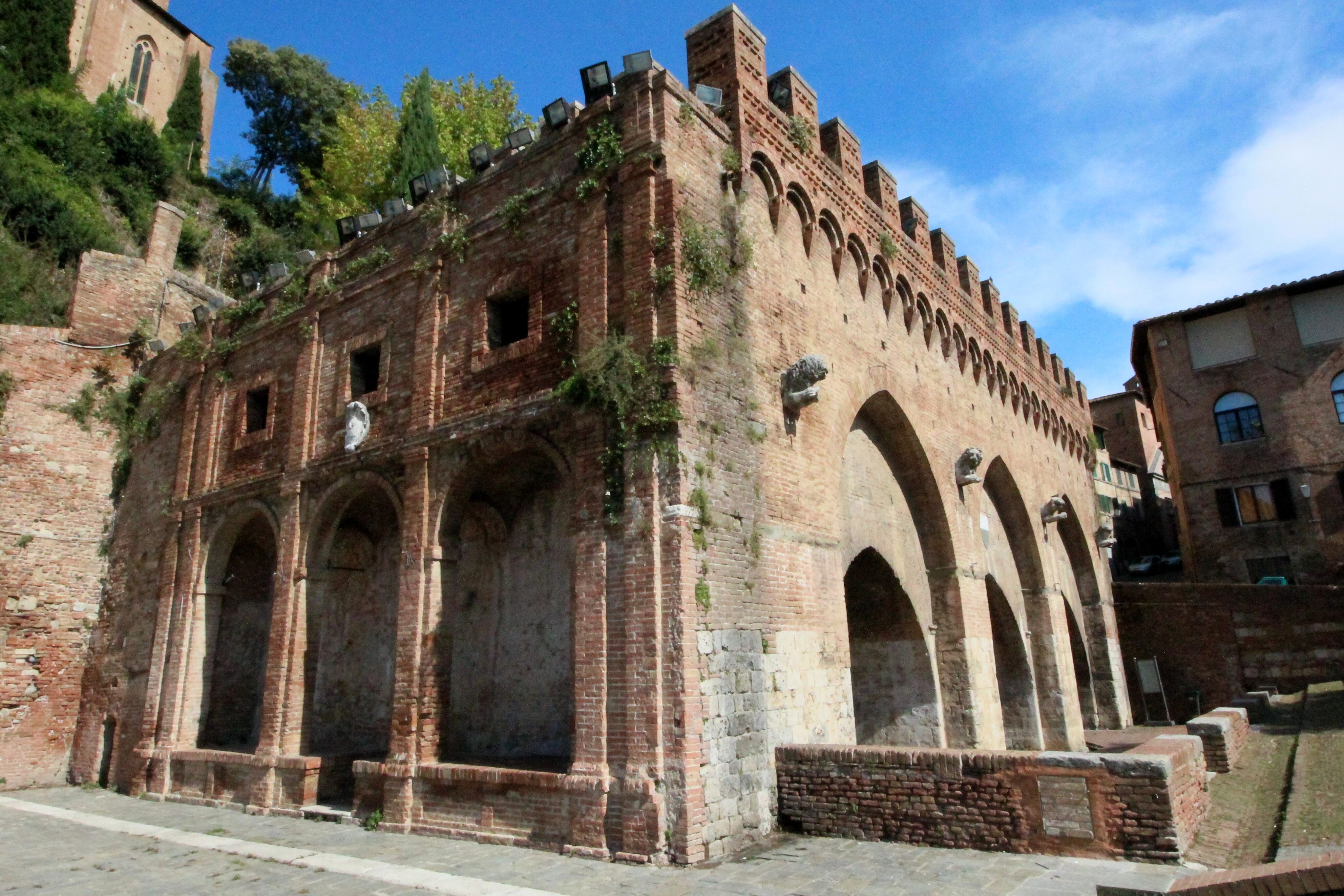
|
Fountain Fontebranda, inside the walls of Siena [2]
|
Structure
The fountain front has three Gothic arches and a crenellated roof. The roof spans a tank fed by water traveling for kilometers to reach the city.
|
| |
|
|

Fountains in Siena | Gallery of images
|
|
|
The main fountains in Siena
|
|
|
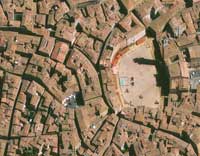 |
|
 |
|
 |
Shadow of The Torre del Mangia on the Piazza del Campo, framing the Fonte Gaia
|
|
Panels of the Fonte Gaia (Fountain of Joy), piazza del Campo, Siena. The originasl were the work of Jacopo della Quercia (ca. 1367–1438). Badly deteriorated by long exposure to the elements, the fountain was entirely replaced in 1868 by a copy made by neo-Renaissance sculptor Tito Sarrocchi (1824–1900).
|
 |
|
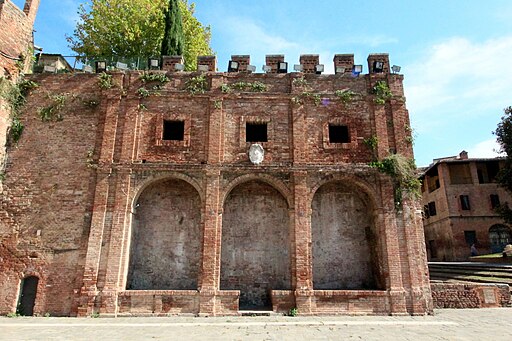 |
|
 |
| Fontebranda |
|
Fonte Branda
|
|
Fonti di Fontebranda |
 |
|
 |
|
 |
| Fonte d'Ovile |
|
Fonte d'Ovile
|
|
Fonte d'Ovile |
 |
|
 |
|
 |
Fonte Nuova d'Ovile
|
|
Fonte Nuova |
|
Fonte Nuova di notte
|
| |
|
|
|
|
| |
|
Fonte di Follonica |
|
Fonte del Casato |

|
|
|
|
|
Fonte di Pescaia
|
|
|
|
|
| |
|
|
|
|
| |
|
|
|
|
 |
|
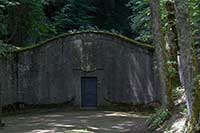 |
|
|
Le fonti di Siena e i loro
aquedotti (1906)
|
|
La sorgente dell'Ermicciolo, Vivo’Orcia, Monte Amiata |
|
|
Minor fountains
|
|
|
| |
|
|
|
|
Fonte delle Monache
|
|
Fonte di San Maurizio |
|
Fonte di Pantaneto |
| |
|
|
|
|
Fonte dei Pispini
|
|
Fonte di San Carlo |
|
Fonte dell'Orto Botanico |
| |
|
|
|
|
Fonti nella valle di Porta Giustizia
|
|
Fonte del Laterino |
|
Fonte delle Sperandie |
| |
|
|
|
|
Fonte Caccialupi
|
|
Fontebecci |
|
Fonte delle Cannelle |
| |
|
|
|
|
| Fonte della Prodaia |
|
|
|
|
Bibliography
Toscana. Guida d'Italia (Guida rossa), Touring Club Italiano, Milano 2003. ISBN 88-365-2767-1
|
 |
|
|
|
|
Fonte Gaia in piazza del Campo a Siena, 1856, Archivi Alinari, Firenze
|
|
|
|
|
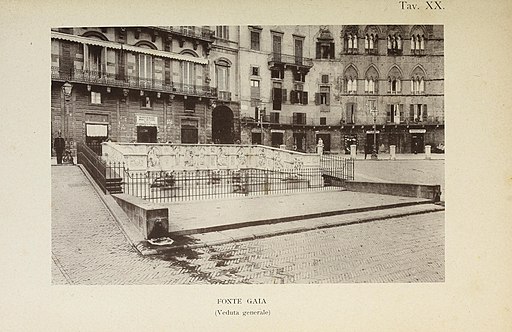
Fonte Gaia, veduta generale |
|

Fonte Gaia, il braccio sinistro |
|
 |
|
|
|
|
Acca Larentia
|
 |
|
|
|
|
Faluschi discusses the vibrant life of Fontebranda in his Breve relazione, page 223. For the fountains, Fabio Bargagli Petrucci's work (Le fonti di Siena e i loro acquedotti) remains valuable, but also see the Associazione La Diana's works . The Museo dell' Acqua at Fonte di Pescaia has a lively interactive exhibit showing what some of the fountains looked like. [3]
Fabio Bargagli Petrucci, Le fonti di Siena e i loro aquedotti, note storiche dalle origini fino al MDLV, 1906, Siena : Olschk
Click here to view book online to see this illustration in context in a browseable online version of this book.
Web page on Open Library | Web | pdf | epub
Full text of "Le fonti di Siena e i loro aquedotti, note storiche dalle origini fino al MDLV"
Catoni G., Il fiero Podestà. Fabio Bargagli Petrucci e il patrimonio di Siena, Siena, Fondazione Monte dei Paschi di Siena, 2010
Le fonti di Siena e i loro aquedotti, note storiche dalle origini fino al MDLV, 1906 | Galleria fotografica |
|
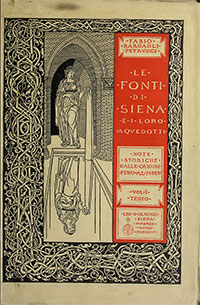
Le fonti di Siena e i loro aquedotti, note storiche dalle origini fino al MDLV, 1906
|
Michael P. Kucher, The Water Supply System of Siena, Italy: The Medieval Roots of the Modern Networked City, Routledge, 2005, ISBN: 9780415971669
Siena's Contrada Fountains | map | Google site | sites.google.com
Scappini, Chiara. History, preservation and reconstruction in Siena. | www..rucore.libraries.rutgers.edu/
Through an examination of pertinent documents, Scappin explains how the nineteenth-century project to restore the fountain, stimulated by the Risorgimento, was a reflection of the social and political history of Siena and of modern Italy. Visual evidence indicates that Sarrocchi’s revival sculpture, currently in situ, cannot be considered a copy of Quercia’s Fonte Gaia, but rather a variant of it.This dissertation demonstrates how Sarrocchi’s fountain --heavily influenced by the Italian art movement Purism and the prevailing restoration theories that circulated in Siena at the time -- reflects the reception of Renaissance art in the nineteenth century.

[1] Photo by Joanbanjo, licensed under the Creative Commons Attribution-Share Alike 3.0 Unported license.
[2] Photo byLigaDue, licensed under the Creative Commons Attribution-Share Alike 4.0 International license.
[3] Jane Tylus, Siena: City of Secrets, University of Chicago Press, 2015
Gaia
Sources
|


|
|
|
|
|
|
|
|
Celebrare il dolce far niente
|
|
Podere Santa Pia is an authentic holiday home in Castiglioncello Bandini, a small village in the Maremma, in southern Tuscany. Podere Santa Pia, situated in a breathtaking setting in the south of Tuscany, incorporates the perfect harmony for man and nature.
Podere Santa Pia is the ideal place to pass a very relaxing holiday in contemplation of nature. Waking up at dawn to start hiking, learning once again the names of flowers and trees, and above all, having the pleasure of getting lost, forgetting about guides, clocks and timetables.
The central location of the holiday home allows you to visit the nearby beautiful villages Montalcino, Sant'Antimo, Pienza, S. Quirico d'Orcia and in the south Saturnia and Sorano - known for its beautiful Sasso Leopoldo. And the sea is 38km away in Marina di Grosseto.
Case vacanza in Toscana | Podere Santa Pia
|
|
| |
|
|
|
|
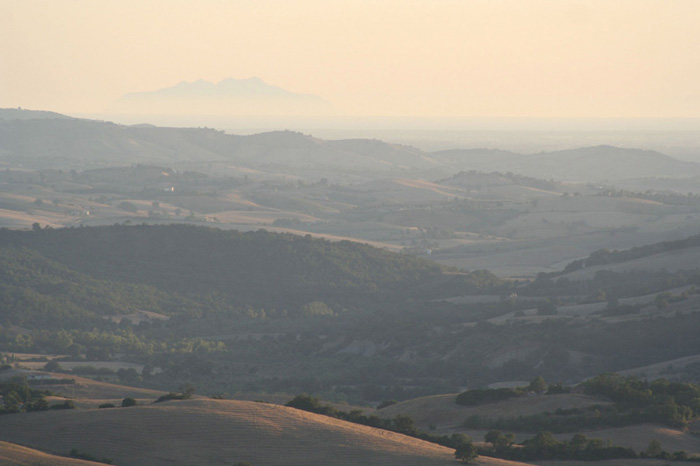 |
|
Questo articolo è basato sugli articoli Fonte Gaia, Fontebranda, Siena, dell' enciclopedia Wikipedia ed è rilasciato sotto i termini della GNU Free Documentation License.
|
|
|
![]()
![]()
![]()
![]()
![]()






















